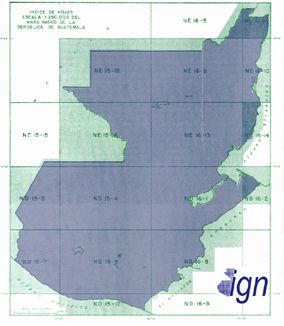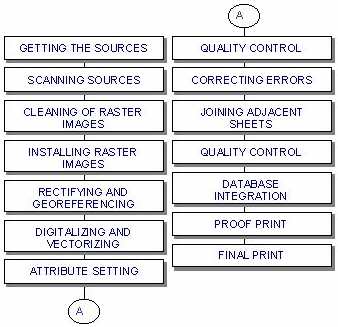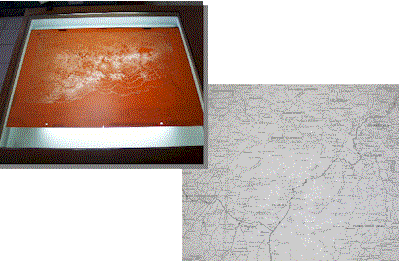

 |
National Geographic Information System |
 |
By: Mónica Ruano and Miriam Aguilera.
![]()
![]()
![]()
![]()
![]()
![]()




Scanning of the sources: upon getting the sources ready, the next step is scanning. Scanned sources were: roads, drainage, contour lines, and administrative division layers. As an additional reference information, the geographic coordinates of every topographic sheet were also included.
Cleaning of the raster images: scanning produces raster format images. The scanning process causes spots in the images. The spots are therefore erased using appropriate software.
Installing raster images in the computer: first, the images are installed in the workstation, taking as reference the four vertices in each image that contain the geographic coordinates. The software generates an automatic process which converts these coordinates into UTM (Universal Transverse Mercator), used for rectifying and georeferencing the image.
Digitalizing and Vectorizing: we used ARC INFO 7.1.2 for both processes. Some programming in AML was required to automate frequently used commands and tasks.
Attributes Setting: attributes were set depending on the nature of the layers. E.g., the roads network (rca) uses a classification (Central American, national or state), a condition (all-weather, hard surface, all-weather loose surface, dry loose surface, track) and the number of classification (CA-1,10).
Quality Control: after digitation and vectorization of each layer are completed, a partial print is produced to confront the digitized information against the sources of information. If any errors are found, they are corrected.
Joining adjacent sheets: next step after verifying the information of the 13 sheets, is to join adjacent sheets in order to obtain layers for the total Guatemalan territory.
Quality Control: the work would not be finished if the quality of the final information is not verified. First, the information per sheet was viewed in ARC VIEW 3.1, then it was printed and verified again against the information sources.
Database Integration: this is the last step of the technical process. All the digitalized information is integrated. The geographic information is ready to be used for developing applications or for a final print.
![]()
National Geographic Institute of Guatemala (IGN) http://www.ign.gob.gt
Secretariat of Planning and Programming for the Presidency (SEGEPLAN) http://www.segeplan.gob.gt
National Institute of Statistics (INE) http://www.ine.gob.gt
Del Valle University http://www.uvg.edu.gt
![]()
* Interinstitutional Unit
* United States Agency for International Development (US-AID)
* National Geographic Institute - France
International (IGN-FI)
![]()